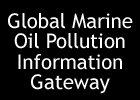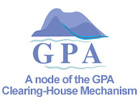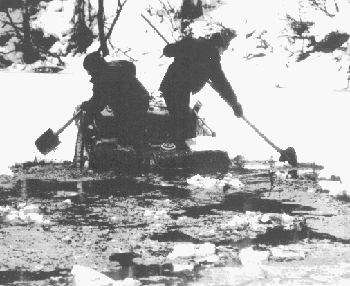|
International
actors and agreements in the region
 See
Global action and Global
actors.
See
Global action and Global
actors.
 UNEP
Regional Seas Programme (with the Arctic as a partner
sea area):"A combination of several factors makes
the Arctic and its inhabitants among the most exposed
populations in the world. The biggest concerns today
are the effects from long-range air and sea transport
of contaminants and certain human activities such as
interference with ancient animal migration routes, oil
and chemical spills into the sea, and the unforeseen
impacts from climate change causing the melting of the
ice cover. Many of these impacts will take a very long
time to reverse: the low temperatures mean slow chemical
breakdown of contaminants, whereas populations of large
mammals can be slow to recover." ••>
UNEP
Regional Seas Programme (with the Arctic as a partner
sea area):"A combination of several factors makes
the Arctic and its inhabitants among the most exposed
populations in the world. The biggest concerns today
are the effects from long-range air and sea transport
of contaminants and certain human activities such as
interference with ancient animal migration routes, oil
and chemical spills into the sea, and the unforeseen
impacts from climate change causing the melting of the
ice cover. Many of these impacts will take a very long
time to reverse: the low temperatures mean slow chemical
breakdown of contaminants, whereas populations of large
mammals can be slow to recover." ••>
 UNEP
Global programme of action for the protection of the
marine environment from land-based activities (UNEP
GPA). ••>
UNEP
Global programme of action for the protection of the
marine environment from land-based activities (UNEP
GPA). ••>
 UN
Economic Commission for Europe, UN ECE. ••>
UN
Economic Commission for Europe, UN ECE. ••>
 UNEP:s
Regional Office for Europe. ••>
UNEP:s
Regional Office for Europe. ••>
Regional
conventions, agreements, action plans and actors
 Arctic
Environmental Protection Strategy. ••>
Arctic
Environmental Protection Strategy. ••>
- Arctic
Monitoring and Assessment Programme (AMAP). ••>
- Conservation
of Arctic Flora and Fauna (CAFF). ••>
- Emergency
Prevention, Preparedness and Response (EPPR). ••>
- Protection
of the Arctic Marine Environment. ••>
- Working
Group on Sustainable Development (SDWG). ••>
 Arctic
Council.
••>
Arctic
Council.
••>
 Barents
Euro-Arctic Council.
••>
Barents
Euro-Arctic Council.
••>
 Paris Memorandum of Understanding on Port State Control.
••>
Paris Memorandum of Understanding on Port State Control.
••>
 Convention
for the Protection of the Marine Environment of the
North-East Atlantic • OSPAR Commission.
••>
Convention
for the Protection of the Marine Environment of the
North-East Atlantic • OSPAR Commission.
••>
Regional
reports on the state of the marine and coastal environment
 AMAP:
State
of the Arctic Environment Report. First assessment
with respect to pollution issues.
AMAP:
State
of the Arctic Environment Report. First assessment
with respect to pollution issues.
 OSPAR
Quality Status Report 2000 Region I: Arctic
Waters.
OSPAR
Quality Status Report 2000 Region I: Arctic
Waters.
 European
Environment Agency (EEA): State
of the European Arctic Environment.
European
Environment Agency (EEA): State
of the European Arctic Environment.
 EEA: State of the Environment Information System —
Arctic.
EEA: State of the Environment Information System —
Arctic.
 UNEP:
Global
Environment Outlook 3 (GEO3). Coastal and marine
areas.
UNEP:
Global
Environment Outlook 3 (GEO3). Coastal and marine
areas.
 UNEP
GPA: Arctic
Region (brief description of environmental state,
priority issues, etc.).
UNEP
GPA: Arctic
Region (brief description of environmental state,
priority issues, etc.).
 UNEP
GRID–Arendal: Artic
Map Server. Presents environmental variables and
parameters on the environment in the Arctic region.
UNEP
GRID–Arendal: Artic
Map Server. Presents environmental variables and
parameters on the environment in the Arctic region.
 University
of Rhode Island: Large Marine Ecosystems (LME): The
region includes the Kara
Sea, the Laptev
Sea, the
East Siberian Sea, the Beaufort
Sea, the Chukchi
Sea, and the Barents
Sea.
University
of Rhode Island: Large Marine Ecosystems (LME): The
region includes the Kara
Sea, the Laptev
Sea, the
East Siberian Sea, the Beaufort
Sea, the Chukchi
Sea, and the Barents
Sea.
Other
publications on marine oil pollution:

 Norwegian University of Science and Technology:
Recovery of oil spills in marine Arctic regions.
Norwegian University of Science and Technology:
Recovery of oil spills in marine Arctic regions.

 Minerals
Management Service: Detection
and Tracking of Oil under Ice.
Minerals
Management Service: Detection
and Tracking of Oil under Ice.
 World
Conservation Union (IUCN): Oil
and Gas Exploration and Production in Arctic and Subarctic
Onshore Regions: Guidelines for Environmental Protection.
World
Conservation Union (IUCN): Oil
and Gas Exploration and Production in Arctic and Subarctic
Onshore Regions: Guidelines for Environmental Protection.
Private
sector and NGOs actors and initiatives
 World
Wide Fund for Nature,WWF, Arctic
Programme.
World
Wide Fund for Nature,WWF, Arctic
Programme.
 International
Tanker Owners Pollution Federation, ITOPF. ••> International
Tanker Owners Pollution Federation, ITOPF. ••>
 International Directory of Oil Spill Cleanup Contractors
and Response Organisations. ••>
International Directory of Oil Spill Cleanup Contractors
and Response Organisations. ••>
 International
Petroleum Industry Environmental Association (IPIECA).
••>
International
Petroleum Industry Environmental Association (IPIECA).
••>
|
 |
National
action: CANADA
 Environment Canada • Environnement Canada
Environment Canada • Environnement Canada
•
National
Programme of Action for the Protection of the Marine
Environment from Land-Based Activities.
•
Environmental
Emergencies.
•
Summary
of Spill Events in Canada 1984-1995.
•
Oil,
Water and Chocolate Mousse.
•
Oiled
Bird Rehabilitation Program.
 Canadian Coast Guard • Garde côtière
canadienne
Canadian Coast Guard • Garde côtière
canadienne
•
Environmental
Response.
 Indian and Northern Affairs Canada • Affaires indiennes
et du Nord Canada
Indian and Northern Affairs Canada • Affaires indiennes
et du Nord Canada
•
Northern
Oil and Gas.
National
action: DENMARK

 National
Environmental Research Institute and Geological Survey
of Denmark and Greenland: Environmental
Oil Spill Sensitivity Atlas for the West Greenland Coastal
Zone..
National
Environmental Research Institute and Geological Survey
of Denmark and Greenland: Environmental
Oil Spill Sensitivity Atlas for the West Greenland Coastal
Zone..
National
action: NORWAY
 Norwegian
Petroleum Directorate
Norwegian
Petroleum Directorate
 Norwegian
Pollution Control Authority
Norwegian
Pollution Control Authority
 Norwegian
Coastal Authority
Norwegian
Coastal Authority
 State
of the Environment Norway
State
of the Environment Norway
National
action: RUSSIAN FEDERATION
 PAME: National
Plan of Action for the Protection of the Arctic Marine
Environment from Anthropogenic Pollution in the Russian
Federation.
PAME: National
Plan of Action for the Protection of the Arctic Marine
Environment from Anthropogenic Pollution in the Russian
Federation.
 Ministry of Natural Resources: North-West Federal District:
State
of the Environment.
Ministry of Natural Resources: North-West Federal District:
State
of the Environment.
National
action: UNITED STATES
 National Oceanographic and Atmospheric Administration
(NOAA ):
National Oceanographic and Atmospheric Administration
(NOAA ):
• Office
of Response and Restoration;
• National
Ocean Service
• Damage
Assessment and Restoration Program.
 US Coast Guard (USCG):
US Coast Guard (USCG):
• National
Response Centre.
• Marine
Safety and Environmental Protection
• Spills
in U.S. Waters, Annual Data and Graphics, 1969-2000.
 U.S.
Environmental Protection Agency (EPA):
U.S.
Environmental Protection Agency (EPA):
•
Regional Office Alaska: Regional
priorities: Oil and gas.
• Oil
Spill Learning Centre.
• Emergencies
(with contingency plans, emergency preparedness and
response).
 US
Department of the Interior:
US
Department of the Interior:
• National
program
• Offshore
Minerals Management
• Alaska
Offshore Region
 Alaska
Department of Environmental Conservation: Division
of Spill Prevention and Response.
Alaska
Department of Environmental Conservation: Division
of Spill Prevention and Response.
 Alaska Department of Natural Resources: Division
of Oil and Gas
Alaska Department of Natural Resources: Division
of Oil and Gas
 Alaska
Oil and Gas Conservation Commission.
Alaska
Oil and Gas Conservation Commission.
|



